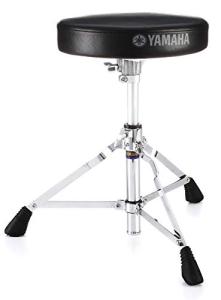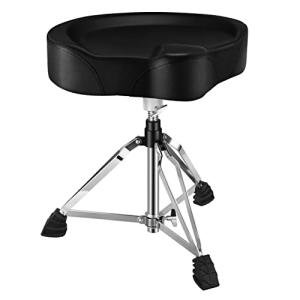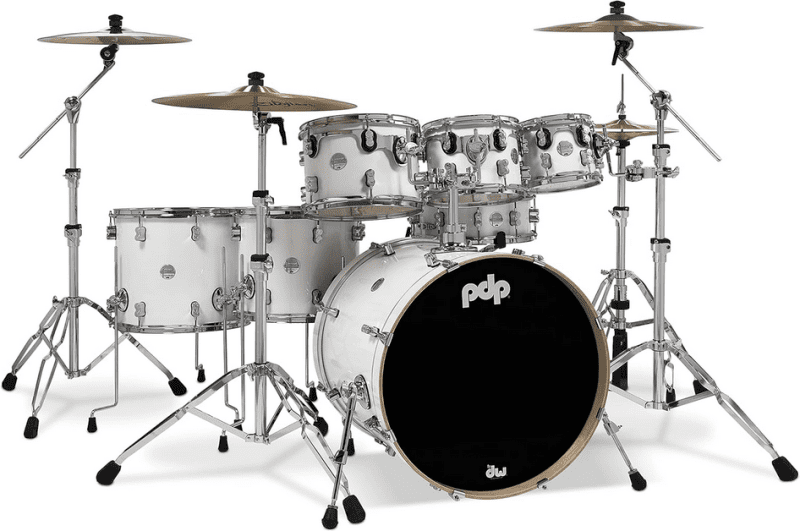Drumming Drills For Beginners

Stepping behind a drum kit can be as thrilling as it is daunting for novices. Many beginner drummers encounter the hurdle of where to begin their rhythmic journey, often overlooking the necessity of foundational exercises that pave the way to mastery.
With years of experience in instructing budding percussionists, I bring you tried-and-true methods that ensure your first beats are not just noise but the beginning of a well-tuned skill set.
The path from tapping idly on tabletops to executing precise drum fills is lined with discipline and smart practice—starting with vital drills tailored just for newcomers to the craft.
Grounded in expert recommendations, like those from Drumeo's co-founder Jared Falk, these exercises aim at building speed, control, and most importantly—confidence behind your drum set.
Discover how rudimentary warm-ups can transform your play; let's dive into techniques that resonate!
Key Takeaways
- Start with basic drumming exercises like single stroke rolls, double stroke rolls, and single paradiddles to build coordination and strength.
- Use a metronome during practice to improve timing and gradually increase speed for exercises like sixteenth-note patterns and stickings.
- Mix up your practice routine with lateral motion drills and drum set drills to boost movement around the kit and enhance overall playing skills.
- Record yourself to identify areas that need improvement, helping you correct mistakes and track progress over time.
- Consistent daily practice using these beginner drills is essential for developing speed, control, and confidence behind the drums.
Essential Warm-Up Exercises for Beginner Drummers

Before diving into the heart-pounding world of drumming, it's crucial to limber up those wrists and fingers, ensuring your technique is both smooth and sustainable. Think of these essential warm-up exercises as your rhythmic stretches - they're the foundation upon which all future beats are built.
Single Stroke Roll
Starting your drumming journey begins with mastering the single stroke roll. This fundamental exercise builds coordination and strength.
- Grab your drum sticks and sit at your drum kit.
- Position yourself comfortably, ensuring that your feet can reach the bass drum and high hat pedals easily.
- Start by hitting the snare drum with one stick at a time – right, left, right, left.
- Keep each stroke even in volume to create a steady sound on the snare.
- Move the beat around the kit, from snares to toms to cymbals while maintaining the rhythm.
- Focus on alternating strokes; don't let one hand do more work than the other.
- Use a metronome to keep your tempo consistent as you play. Start slow, maybe 60 beats per minute (bpm).
- As you get comfortable, gradually increase your speed while keeping clean hits.
- Practice shifting the single stroke roll across different parts of the kit – hit the high hat, then move to floor tom or kick drums for variation.
- Aim for precision in every note. Even if they're soft or loud, make sure they're intentional.
- Experiment with dynamics by playing some notes harder and others softer within your roll.
- Keep wrists loose and relaxed; stiff movements can slow you down and cause strain.
Double Stroke Roll
After mastering the single stroke roll, it's time to level up with the double stroke roll. This drum rudiment is a crucial step for beginner drummers to gain speed and endurance.
- Begin slowly: Start with your sticks close to the drum surface. Hit the drum twice with one stick, then twice with the other.
- Focus on evenness: The goal is to make both strokes sound the same in volume and tone.
- Use a metronome: Play along with a metronome to keep your beats steady and consistent.
- Relax your grip: Hold your sticks loosely. A tight grip can slow you down and tire you out.
- Gradually increase speed: As you get comfortable, slowly raise the tempo on your metronome.
- Practice daily: Make double strokes part of your routine to see improvement.
- Pay attention to technique: Good form now will prevent bad habits later. Look at how you hold your sticks and strike the drums.
Single Paradiddles
Single paradiddles are a mix of single and double strokes that build your coordination. Practice them on different drums to boost your speed and control.
- Start slow, using a metronome. Set a pace where you can play cleanly. This helps your timing.
- Lead with either hand. Try leading with your right, then your left. This makes both hands strong.
- Say the pattern out loud: "Right-left-right-right, left-right-left-left." Hearing it helps reinforce the movements.
- Move around the kit. Hit the snare, then the toms, and so on. This develops lateral motion skills.
- Keep a steady rhythm. Don't rush the doubles or lag on singles. Aim for consistent sound from each stick hit.
- Increase speed gradually. As you get more comfortable, nudge up the metronome's tempo slightly.
- Focus on stick heights. Keep them even to produce uniform volumes across all notes.
- Use drum rudiments books for practice variations. They offer new ways to apply single paradiddles around your drum kit.
- Record yourself playing. Listen back to spot areas that need work and track your progress over time.
- Mix in other rudiments like flams and triplets between paradiddles to stretch your creativity and dexterity.
Drills for Developing Speed and Control

Mastering the drums is all about the finesse of speed and precision, but developing these skills takes dedicated practice. Engage in targeted drills that challenge your coordination and dexterity, laying a foundation for more complex rhythms you'll conquer with time.
Sixteenth-Note Patterns
Sixteenth-note patterns are key for building speed and precision on the drums. They help you play faster while keeping control.- Start slow with a metronome. Set it to a comfortable speed where you can play without mistakes.
- Play four sixteenth notes on the snare for every click of the metronome. Count "1 e & a, 2 e & a, 3 e & a, 4 e & a."
- Keep your stick heights even. This will make your drumming sound steady and controlled.
- Gradually increase the metronome speed. Do this only after you can play well at the slower tempo.
- Move the pattern around the drum kit. Hit different drums or cymbals for each note to create various sounds.
- Practice alternating hands. Lead with your left hand if you're right-handed and vice versa for balance.
- Add bass drum notes. Include them on counts one and three to start, then try adding them to other beats.
- Work in some double - stroke roll techniques with these patterns. This builds independence between hands and helps with fluidity.
Stickings
Stickings are key to mastering drum kits. They help you play rhythms cleanly and with ease.
- Start with a simple right-left sticking pattern. Play this on the snare drum to get comfortable moving your sticks.
- Practice alternating sticking at different speeds. Use a metronome to keep consistent timing as you speed up or slow down.
- Mix in accents with your stickings. Hit some notes louder than others to create dynamic patterns.
- Try the flam tap, where one hand plays a light note followed by a heavier note from the other hand. This develops control over stick heights.
- Add doubles into your practice routine. It's playing two hits with the same hand before switching to the other.
- Reverse your usual sticking patterns for a challenge. If you usually start with your right, start with your left instead.
- Incorporate stickings into drum fills across all parts of your kit. Move around the toms and cymbals using varied stickings.
Linear Fills
After mastering stickings, you can dive into the world of linear fills. These drum exercises are key for a clean, articulate drumming style. Here's how to get started:
- Start slow with a metronome set to a comfortable pace. This builds your time-keeping skills.
- Play each note distinctly and don't rush. Clear hits on the drum give each fill its unique sound.
- Begin with single strokes across the drums in succession. Move from snare to tom-toms to cymbals.
- Add kicks on the bass drum to break up hand patterns. Keep them steady and controlled.
- Mix in hi-hat hits with both hands and feet. This adds variety and challenges your coordination.
- Practice moving around different parts of the kit smoothly. This helps create seamless transitions during fills.
- Increase your speed gradually as you become more confident. Always focus on keeping a steady rhythm.
- Use different time signatures to expand your versatility. Try playing linear fills in 3/4, 4/4, or even 7/8 time.
- Experiment with rhythmic patterns within your fills such as triplets or sixteenth notes for complexity.
- Record yourself playing to spot areas that need improvement. Listen back and adjust your technique accordingly.
Practical Exercises for Beginning Drummers
Dive right into practical exercises tailored for the novice drummer, where mastering fundamental techniques transforms your rhythm and coordination—prepare to embark on a journey from simple beats to dynamic drumming.
Keep reading to elevate your drum prowess!
Lateral Motions
Moving around the drum set quickly and smoothly is key for beginners. Lateral motion exercises help build this essential skill.
- Start with your hands at the snare drum. Hit the center, then move to hit the hi-tom, mid-tom, and floor tom in sequence.
- Keep your movements relaxed. Tense arms will slow you down and tire you out.
- Practice leading with both your left and right hand. This builds balance and coordination.
- Use a metronome to keep your pace steady. You'll be able to track your improvement over time.
- Aim for fluid motion rather than speed at first. Speed will come as you get more comfortable moving around the drums.
- Gradually increase the metronome's tempo as you grow more confident in your motions.
- Try adding a flam-tap between each drum hit. It adds complexity and prepares you for more advanced techniques.
- Incorporate your feet by hitting the bass drum as you move from one drum to another.
- For a real challenge, double up on each drum before moving to the next using double-stroke rolls.
- Record yourself to see where you need to improve. Watching can help correct bad habits early on.
Drum Set Drills
Moving from lateral motions to drum set drills, you'll find that these exercises enhance your overall playing. Drum set drills help you feel at home behind your kit. Let's dive into some key practices.
- Start with a simple beat. Use your kick pedal for the quarter notes and snare for backbeats. This basic rhythm is your foundation.
- Add hi-hat hits. Play eighth notes on the hi-hat along with your basic beat. Keep it steady.
- Practice moving around the toms. Start slow and strike each tom in sequence, both down and up the kit.
- Include the crash cymbal. Hit the crash at the beginning of a new measure then return to your basic beat.
- Work on bass drum control. Play different patterns with just the bass drum while keeping a steady rhythm on the hi-hat.
- Incorporate rudiments into your beats. Mix in single strokes or doubles between snare and hi-hat parts.
- Track time with built-in metronomes, like those in Yamaha electronic drum kits, to stay consistent.
- Speed up gradually. Push your tempo limits without sacrificing precision or timing.
- Alternate your leading hand. Lead with your left hand if you're right-handed and vice versa; it builds ambidexterity.
- Create fills using linear patterns; hit only one drum or cymbal at a time in a sequence.
Conclusion
You've got the basics, now it’s time to practice. Start slow, then build up speed as you get comfortable. Remember, every drummer started just where you are – at the beginning.
Keep at it and have fun; that's what drumming is all about. Your journey is just taking off -- enjoy every beat!
FAQs
1. What are some basic drumming drills for beginners?
Beginners can start with simple patterns on the snare drum — think of it as getting to know your drum's voice. Then, move onto kick drums and practice coordinating your feet — that's right, both feet. Your double bass pedal will thank you later!
2. How often should I practice these drumming drills?
Consistency is key! Try to hit those drums daily, even if just for a few minutes. Regular practice builds muscle memory and trust me; you'll feel the difference.
3. Where can I find more advanced drumming exercises once I've mastered the basics?
Your inbox won't be lonely — sign up for online lessons or check out tutorials from pro-drummers! Just steer clear of the spam folder; nothing useful beats in there.
4. Can practicing too much too fast be harmful when learning to play drums?
Pace yourself! Starting slow ensures you nail the technique without strain or injury – remember; it's a marathon, not a sprint towards rock stardom.
DISCLAIMER
This document is provided for general information purposes only and should not be relied upon as providing legal advice, technical, or specific operational guidance to the reader, whether as to the practices described in the document or the applicable legal requirements and regulations. Pro Percussion.Com expressly disclaims any responsibility for liability arising from or related to the use or misuse of any information in this document.





